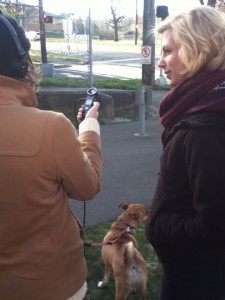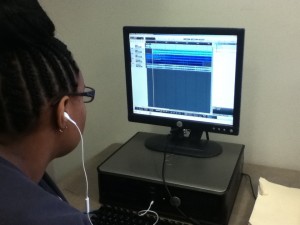
At Arts Corps, we take time to learn from each other’s art forms to develop our own creative perspectives. In this spirit, the AmeriCorps team took turns facilitating Artist Development workshops this year.
Collectively, we expressed with written and spoken word, experimented with visual art, and examined our auditory senses.
I enjoyed leading a workshop on the basics of field recording – getting the team to learn how to use audio equipment, as well as spending an afternoon creating soundscapes with field recordings.
At the heart of these workshops, and at the heart of audio production itself, is an emphasis on critical listening.
I modeled the same theme for my students this year, beginning my Digital Audio Project lesson for Washington State History with a discussion of the difference between hearing and listening. Some students were utterly confused.
“There is no difference” some of them said, instinctively. It was quickly debunked that hearing is something you do without thinking about it; listening, on the other hand, involves active participation and attention to how something sounds.
They took this skill into their project research, examining songs from the 1960’s and 70’s with social justice themes, such as “Strange Fruit” by Billie Holiday, “Choice of Colors” by The Impressions, and “Say It Loud, I’m Black And I’m Proud,” by James Brown. The students chose one song to research and reinterpreted the song to show a connection to current events in their community.
After months of meticulously planning the curriculum, I thought I was ready to perfectly execute an integrated arts lesson without a hitch! But as it goes, many barriers changed the way my structured curriculum played out. We collided with testing season, which made the computer labs inaccessible to the class for several days, we experienced software failure on the computers, and ultimately, I underestimated the time that was needed for students to effectively complete their projects.

After a few adjustments in the requirements and nearly a two-week deadline extension, I’ve learned that there is so much more planning and care that goes into building an experience than the lesson plan itself. In addition to adapting to institutional challenges, you meet individual minds, with individual learning styles and individual personalities. Then you have to adapt your content and teaching style to suit the needs of those individuals. You, as the teaching artist, become the catalyst for informing and challenging the unique perspectives in the room, so that everyone walks away with a richer sense of purpose within the art form.
I’ve found that middle school students (and all students for that matter) can have trouble breaking out of their established school routine. They are often taught that their grade depends on a final product, but the importance of the drafting and planning processes is often lost. In the creation of art, no matter the form, the initial drafting and planning process is integral to a final product, and bears a great weight on its success. For my Digital Audio Project curriculum, I made the project requirements clear before any work began – the proposal, research, presentation, and self-evaluation would all hold equal weight in the final grade. In this way, students needed to be accountable for themselves – do the research, form the presentation, keep their documents organized, and self-reflect in order to succeed on the project.
Arts integration has served to bring a new mode of thinking and learning into the classroom. It gives students the power to make their voice and perspective relevant to their learning. It has given me the opportunity to show how my non-traditional art form is relevant to young people. It shows students that there is in fact a difference between hearing and listening.
Listen to students reflect on their year in this audio case study:
Arts at Madrona K-8 – audio case study by Amy Pinon
This year, I recognized my personal power to be an agent of social change. With my non-traditional art form being misunderstood and underestimated by the school system, I had to fight to be able to develop my own audio-integrated curricula. Through this, I have learned how to effectively design curricula to set students up for success in completing a project. I have also learned how to be flexible and adaptable to accommodate the standards and schedule of the school system, while still upholding my own standards as well as advocating for the relevance and impact of my art form.
The higher vision that I aspire to in my work is to make audio production and recording technology visible and accessible to young people. I recognize it as a tool for youth engagement and empowerment when often times, youth voices are lost in an oppressive, adultist institution. I am humbled that Arts Corps chose me for this position, knowing that my art form is not one that is so easy to execute or that people will so readily accept as an art form. Through this opportunity, I have been able to bring to light the ways in which sound and recording are relevant to our lives – not just for the students, but for fellow teaching artists, classroom teachers, staff, and my AmeriCorps team. Arts Corps took a risk on me, and I think my work will serve as a platform for audio production to obtain the merit it deserves as a powerful art form alongside all the rest.
-AMY AmeriCorps Artist-in-Residence
